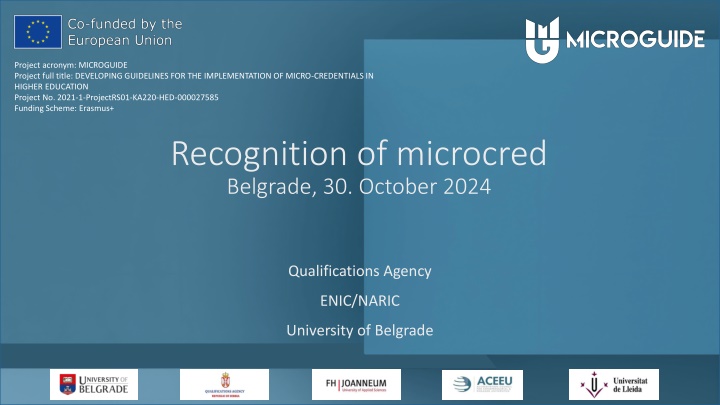
Developing Guidelines for Micro-Credentials in Higher Education
"Explore the implementation and recognition of micro-credentials in higher education, covering factors like quality, recognizability, and evaluation processes. Learn about the steps for recognition and the importance of regional differences in the recognition process. Discover how foreign higher education documents are evaluated for academic or professional purposes, with a focus on the recognition of micro-credentials."
Download Presentation

Please find below an Image/Link to download the presentation.
The content on the website is provided AS IS for your information and personal use only. It may not be sold, licensed, or shared on other websites without obtaining consent from the author. If you encounter any issues during the download, it is possible that the publisher has removed the file from their server.
You are allowed to download the files provided on this website for personal or commercial use, subject to the condition that they are used lawfully. All files are the property of their respective owners.
The content on the website is provided AS IS for your information and personal use only. It may not be sold, licensed, or shared on other websites without obtaining consent from the author.
E N D
Presentation Transcript
Project acronym: MICROGUIDE Project full title: DEVELOPING GUIDELINES FOR THE IMPLEMENTATION OF MICRO-CREDENTIALS IN HIGHER EDUCATION Project No. 2021-1-ProjectRS01-KA220-HED-000027585 Funding Scheme: Erasmus+ Recognition of microcred Belgrade, 30. October 2024 Qualifications Agency ENIC/NARIC University of Belgrade
Microcred in contest of recognition Micro-credentials are short, specific qualifications that typically focus on particular skills or knowledge. The process of recognizing micro- credentials may involve several important factors: 1. **Quality of Education**: Micro-credentials should be accredited by relevant educational institutions or organizations. 2. **Recognizability**: It is important for micro-credentials to be recognized by employers and educational institutions. This may involve collaboration with industry partners. 3. **Recognition Criteria**: The recognition process usually includes the assessment of course content, methodologies, and learning outcomes. 4. **Transparency**: There should be clear criteria and structures for recognition, so participants know what to expect. 5. **Technology**: Many programs use digital badges or blockchain technology for the verification and storage of micro-credentials. 6. **Post-Educational Opportunities**: Recognition of micro-credentials can open up opportunities for further education, career advancement, or professional certification. 7. **Regional Differences**: The recognition process may vary depending on the country or region, which means it is important to understand local legislative and educational frameworks.
Micro-credentials should be recognized through specific procedures that depend on the type of credentials and the institution that issues them. The process typically includes the following steps: 1. **Application**: Candidates must submit an application for the recognition of their micro-credentials to the relevant institution or authority. 2. **Documentation**: It is necessary to attach all relevant documents that confirm the obtained micro-credentials, including certificates, transcripts, and other relevant materials. 3. **Evaluation**: The institution conducts an evaluation of the submitted documents and credentials to determine their equivalence in the educational system. 4. **Decision**: After the evaluation, the institution makes a decision about the recognition or rejection of the micro-credentials. 5. **Notification**: Candidates are notified about the outcome of the recognition process. In some cases, it may be necessary to attend additional courses or training to meet the recognition requirements.
Conclusion Recognition of foreign HE documents is a procedure for the purpose of either to continue the education (academic recognition) or to be employed (professional recognition). The evaluation is done by ENIC/NARIC Centre, as an internal organisational unit of the Qualifications Agency, based on the type and level of competencies achieved by completing the study program or its part, considering the education system in the country where HE document was acquired, the enrolment conditions, the rights arising from the HE document in the country of acquisition and other relevant facts. The evaluation is done without considering the formal characteristics and structure of the study programme, in accordance with the principles of the Lisbon Recognition Convention. Recognition of MCs In order to start professional recognition of foreign MCs they must be embedded in the Law on Higher Education (so far, the MicroGuide results do not imply that is necessary to change the Law on the NQFS). Professional recognition is carried out by the Enic/Naric Centre, as an organizational part of the QARS. According to the Law on the NQFS, for a MCs to be recognised: HEI offering MCs must be accredited; MCs must be accredited; MCs content must be linked to the EQF; MCs workload must be expressed in ECTS. In addition, MCs must have Certificate (and, if appropriate Certificate Supplement) containing the MCs name, type (if in the issuing country there is a division into academic and professional studies), degree and duration, as well as the scientific, artistic, or professional area within which the study program was completed. In this way, conditions would be created for the MCs recognition for the purpose of employment, i.e., their inclusion in the Serbian labour market
Thank you for your attention Vielen Dank f r Ihre Aufmerksamkeit Gr cies per la vostra atenci agencija@azk.gov.rs
